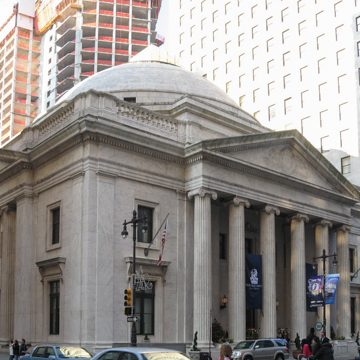You are here
Ritz-Carlton Hotel (Girard Trust Company)
Although the officers of the Girard Trust Company explicitly excluded Furness from their competition because they did not want his usual red brick style, he made drawings for a classical scheme that sailed under the false colors of his partner Allen Evans. The firm was awarded the commission on the condition that McKim, Mead and White serve as consultants on the detailing. Evans took the commission fees—leading to a lawsuit from his partner Furness. Despite its classical surface, Furness adhered to his typical pattern of bank design with a tightly framed entrance opening into a vast top-lighted hall. The change to the four surfaces of a sail vault for the interior from the hemispherical dome of the exterior is a typical Furness reversal of expectation that brilliantly accommodates the great four-sided banking room. The adaptive reuse by Hillier Group imaginatively converted the banking room into the public lobby of the Ritz-Carlton Hotel. The original circular bank tellers’ desk screens the lobby, while the glass floor transmits light to the original safe-deposit room below.
Writing Credits
If SAH Archipedia has been useful to you, please consider supporting it.
SAH Archipedia tells the story of the United States through its buildings, landscapes, and cities. This freely available resource empowers the public with authoritative knowledge that deepens their understanding and appreciation of the built environment. But the Society of Architectural Historians, which created SAH Archipedia with University of Virginia Press, needs your support to maintain the high-caliber research, writing, photography, cartography, editing, design, and programming that make SAH Archipedia a trusted online resource available to all who value the history of place, heritage tourism, and learning.






